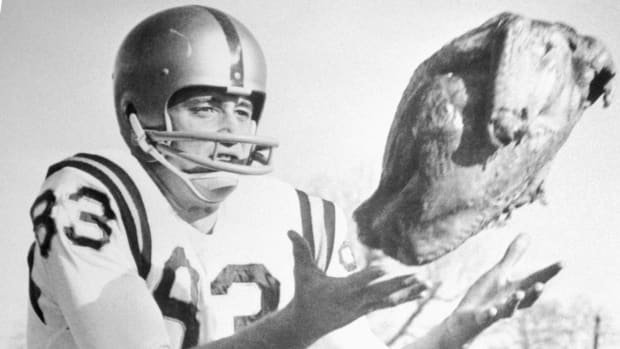The permeation of sports into our holiday traditions is nothing new. Abraham Lincoln signed the proclamation declaring the first official Thanksgiving holiday in 1863. The first Thanksgiving football match took place only six years later in Philadelphia between the Young American Cricket Club and the Germantown Cricket Club. Two weeks earlier, Rutgers had defeated Princeton in what is recognized as the first official collegiate football game. By 1876, the Yale versus Princeton Thanksgiving contest became the unofficial college championship game. At that time, the game was still evolving from the rugby hybrid to the game we know. In 1882, The Intercollegiate Football Association started inviting the top two schools in the country to New York City to play in the Thanksgiving Championship Game. That lasted until 1901 when Michigan became the first non-Ivy League school to win the championship.
The newly formed National Football League scheduled six Thanksgiving Day games in 1920 to generate interest. The struggling Detroit Lions franchise started their holiday tradition against the Chicago Bears in 1934. The game was such a financial success the tradition took root. The fledgling Dallas Cowboys took the same path starting in 1966.
When high schools started playing the game in the early decades of the 20th century, many young men were needed by their families to help harvest the crops in late summer. Therefore, the football season often didn’t start until October. Since there were no playoffs, Thanksgiving Day games were usually the season finale against a traditional rival. The oldest high school Turkey day rivalry is between Boston Latin and English High Schools in Massachusetts. They have played on that date every year since 1887. In Pennsylvania, Easton High School has taken on its rival across the river in Phillipsburg, New Jersey each Thanksgiving since 1916. The winner takes home the Forks of the Delaware Trophy. In eastern Pennsylvania, a handful of these holiday rivalry games continue today despite regional and state playoffs.
Locally, Waynesburg College played its first football contest on October 19, 1895. They beat West Virginia University 10-8 at the old fairgrounds. It is believed the Mountaineers sent their “reserves” because they were expecting an easy win against the “farmers”. Waynesburg then lost back to back away games against Washington & Jefferson and the Mountaineer’s varsity. However, there is confusion about what constituted an official game and what was simply an exhibition. What many consider the Yellow Jackets’ first real game was played on Thanksgiving that year at the Fairgrounds in Waynesburg with the locals avenging their earlier defeat to W&J by a 4-0 score. (Note: A touchdown was worth four points at the time. Two points were awarded for extra points and safeties, while field goals were worth five.) If that were determined to be the first official game, Jesse Hunnell Hazlett scored the first official touchdown in Waynesburg College history at that game. Many of the spectators had no idea of the rules of the game. In fact, most of the players on the roster had never even seen a game before they began the season.
Of course, the big game the following year was against W&J. Students holding purple and Klondike yellow streamers (the school’s colors at the time) led the team in a parade down Washington Street to the W&W narrow-gauge train bound for Washington. Two hundred fans boarded the train with the team to cheer them on. Unfortunately, Waynesburg was on the short end of a 20-0 score. However, the season ended on a high note with a 14-5 Thanksgiving Day victory over Western University of Pennsylvania, the school that would become the University of Pittsburgh in 1908. The following year, the season was canceled due to the Spanish-American War. Football resumed in 1899 with a loss to rival W&J in front of 1,000 spectators at the old fairgrounds. However, they defeated Bethany College and California Normal before concluding the season with a 20-0 victory over WVU on Thanksgiving.
In 1920, Waynesburg High School decided to try to bring back football after a three-year hiatus because of World War I. A six-game schedule was announced in October with home and away games against Morgantown, Cameron, and Claysville. The season was to run from mid-October to Thanksgiving. However, they failed to finish the season because of too many injuries. The 1922 Thanksgiving Day season finale against Washington High School drew 3,000 people to College Field, despite the fact the team was “not exceedingly brilliant,” according to the school’s yearbook. In the 1930s, the WPIAL started using different classifications and expanding the playoffs, and eventually the traditional high school holiday games began to dwindle.
